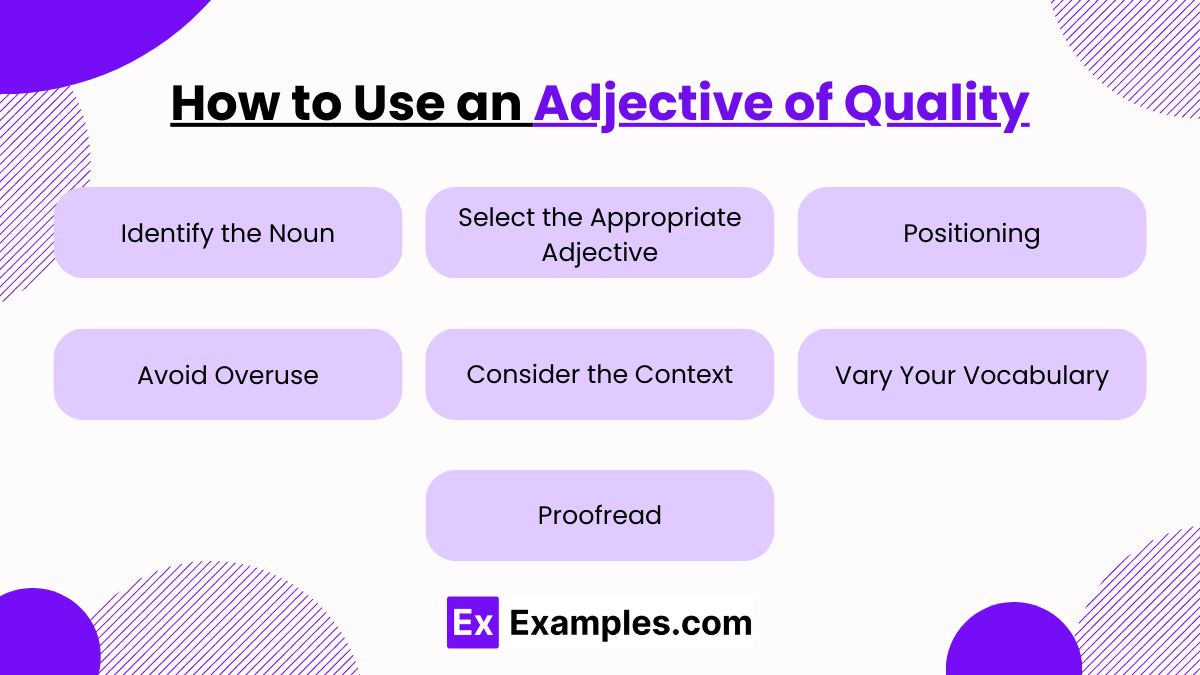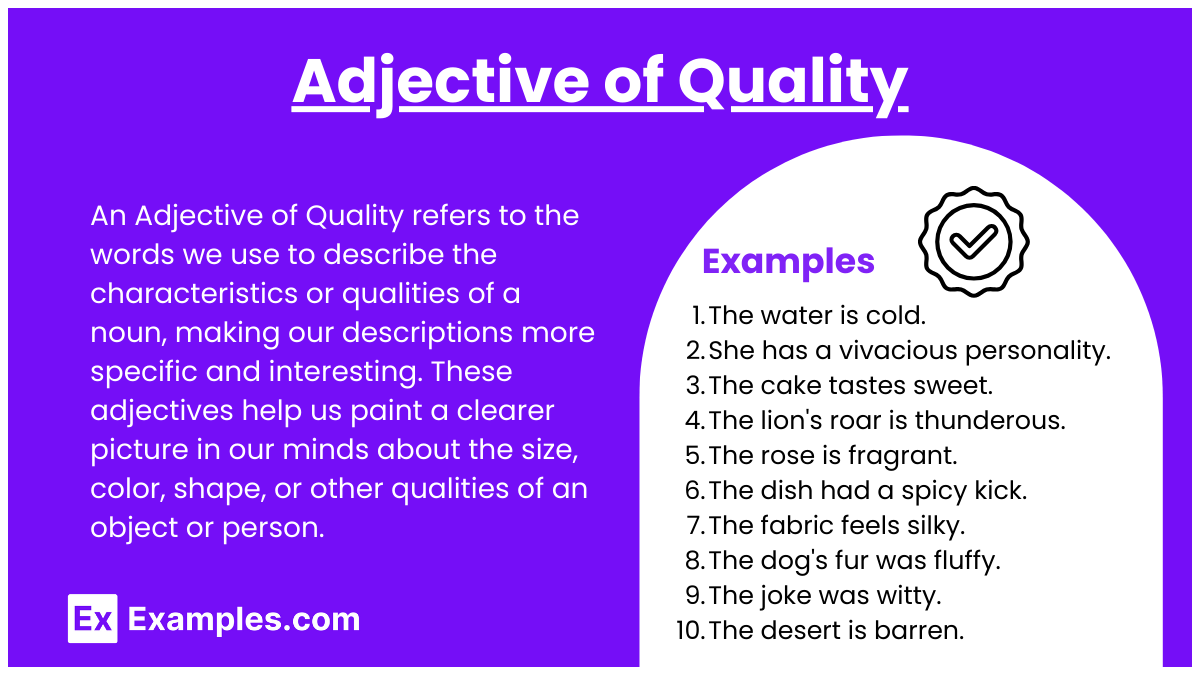99+ Adjective of Quality Examples
An Adjective of Quality refers to the words we use to describe the characteristics or qualities of a noun, making our descriptions more specific and interesting. These adjectives help us paint a clearer picture in our minds about the size, color, shape, or other qualities of an object or person. For example, in the phrase “a tall building,” “tall” is an adjective of quality that gives us more information about the building’s height. Understanding how to use these descriptive words effectively can make our communication more vivid and precise.
What is Adjective of Quality?

100 Adjective of Quality Examples

Adjectives of Quality are the backbone of descriptive language, breathing life into everyday nouns. These words meticulously capture the essence, characteristics, and attributes of the entities they describe. Venture with us as we unfold a curated list of 100 dazzling examples, shedding light on the nuanced world of these descriptive gems.
- The water is cold.
- She has a vivacious personality.
- The cake tastes sweet.
- The lion’s roar is thunderous.
- The book provides comprehensive knowledge.
- The night sky was starry.
- The music was soothing to the ears.
- He is a diligent worker.
- The movie was hilarious.
- That’s an ancient artifact.
- The forest looked mysterious at dusk.
- The diamond sparkled with brilliant radiance.
- Her laughter is contagious.
- The soup smells aromatic.
- He gave a verbose speech.
- The room is spacious.
- The rose is fragrant.
- The fabric feels silky.
- The fiery sun set on the horizon.
- She wore a glistening tiara.
- The forest was dense with trees.
- The perfume had a subtle scent.
- The novel’s plot was intricate.
- She wore a radiant smile.
- The museum exhibited antique artifacts.
- His manners are impeccable.
- The dish had a spicy kick.
- The beach offers a serene view.
- His arguments were convincing.
- The climate here is humid.
- The lecture was informative.
- The dog’s fur was fluffy.
- She is known for her generous nature.
- The gigantic mountain overshadowed the valley.
- The tea is too bitter for my taste.
- The city is bustling with activity.
- She has a melancholic demeanor.
- The child’s eyes were sparkling with mischief.
- The fragile glass broke easily.
- The sculpture looked ethereal in the moonlight.
- The fabric was coarse to the touch.
- The joke was witty.
- The grapes are juicy.
- He possesses a vast knowledge of history.
- The desert is barren.
- The movie’s climax was thrilling.
- The news is reliable.
- The story was heartbreaking.
- The solution was ingenious.
- The path is rocky.
- The smooth road made the drive pleasant.
- The project was laborious.
- Her dress is vibrant.
- The wine is rich and aged.
- The pastry was flaky and delicious.
- The scenic beauty of the place was mesmerizing.
- The fabric is translucent.
- The dog’s bark was loud.
- The riddle was complex.
- The surface was slippery.
- He is talented in multiple arts.
- The village has a rustic charm.
- The noisy market was filled with vendors.
- The cake’s texture was creamy.
- The night was dark and stormy.
- The theme of the event is retro.
- The crispy fries were freshly made.
- The car’s engine is powerful.
- The book is lengthy but worth the read.
- His understanding of the subject is profound.
- The valley was lush with greenery.
- The documentary was eye-opening.
- The soup tasted bland without spices.
- The monument stands as an immortal testament to history.
- The icy roads made driving treacherous.
- Her jewelry is exquisite.
- The meal was sumptuous, satisfying every guest.
- The fiery debate continued for hours.
- The opaque window didn’t let much light in.
- The novel was riveting from start to finish.
- The music had a haunting melody.
- The building has an archaic charm.
- The fruit was ripe and ready to eat.
- The landscape looked surreal in the dawn.
- The speech was eloquent and persuasive.
- The fuzzy texture of the blanket felt cozy.
- His skills are unparalleled in the industry.
- The crystal-clear water was inviting.
- The challenge seemed insurmountable at first.
- The sandy beaches stretched for miles.
- The cavernous hall echoed with voices.
- The golden hues of the sunset were breathtaking.
- The feedback was constructive and helpful.
- The chilly weather called for a warm jacket.
- The game was intense and kept everyone on edge.
- The dewy grass glistened in the morning.
- The painting had a mystical aura.
- The chocolatey dessert was a crowd favorite.
- The mountain’s peak looked majestic.
- The velvety fabric was soft against the skin.
Adjectives of Quality truly encapsulate the beauty and intricacy of the English language. Through their descriptive prowess, they enable writers and speakers to craft detailed and vivid narratives, making experiences, stories, and descriptions come alive for the reader or listener.
Adjective of Quality in Sentence Examples
- The ancient ruins stood majestically under the sun.
- She wore a bright red dress that caught everyone’s attention.
- The soft melody soothed the room into silence.
- He is a kind man who always helps others.
- The bitter medicine was hard to swallow.
- They adopted a playful puppy from the shelter.
- It was a cold and stormy night.
- She offered a warm and welcoming smile.
- The fragile glass shattered into pieces.
- The soup was spicy enough to make my eyes water.
Adjective of Quality Class 4
- The tall tree towered over the playground.
- She has a shiny new bicycle.
- The loud noise startled the birds.
- He carried a heavy backpack to school.
- The sweet apple pie was a hit at the dinner.
- That old bridge has been there for years.
- Her soft voice was barely audible.
- The bright sun made it a perfect day for a picnic.
- He found a smooth stone by the river.
- The dark room felt a bit spooky.
How to Practice Adjectives of Quality

Mastering Adjectives of Quality can greatly enhance descriptive capabilities. Here’s a guide to effectively practicing them:
- Descriptive Writing Prompts: Challenge yourself with prompts. Describe a sunset, the hustle and bustle of a marketplace, or the serenity of a forest. Use a rich array of quality adjectives.
- Interactive Worksheets: Online platforms offer myriad worksheets tailored to adjectives of quality. They can help reinforce understanding through exercises and quizzes.
- Daily Observations: Every day, choose an object or a scene and describe it using five adjectives of quality. It could be your morning coffee, your workstation, or the weather outside.
- Reading: Dive into descriptive literature, poetry, or travel blogs. As you read, underline or note down quality adjectives that stand out.
- Flashcards: Write down a quality adjective on one side and its meaning or a sentence using it on the other. Regularly revisiting these cards can bolster memory and understanding.
- Join Writing Workshops: Participate in workshops or writing groups where peers can provide feedback on your use of adjectives, allowing for refinement and learning.
- Use Technology: Apps focused on vocabulary enhancement can be goldmines for discovering new quality adjectives and practicing them.
The essence of Adjectives of Quality lies in their power to paint vivid images, encapsulate emotions, and convey sensory experiences. Regular practice and mindful application will undoubtedly hone your skill in using them effectively.
How to Use an Adjective of Quality

The ability to proficiently use Adjectives of Quality can be a game-changer in both written and spoken English, allowing for more vivid and expressive communication. Here’s a systematic guide to ensure effective use:
- Identify the Noun: Before you add an adjective, be clear about the noun you’re describing. Determine its main characteristics that you wish to emphasize.
- Select the Appropriate Adjective: Pick an adjective that accurately describes the specific quality or characteristic of the noun. Remember, the adjective should add depth or clarity to your sentence.
- Positioning: Place the adjective directly before the noun it’s modifying. For instance, in “The stormy night was unsettling,” “stormy” is the Adjective of Quality describing “night.”
- Avoid Overuse: While quality adjectives can enrich descriptions, overuse can make sentences heavy and redundant. Choose only the most pertinent adjectives for clarity and impact.
- Consider the Context: The adjective should suit the tone and purpose of your writing or speech. A formal document might require different adjectives than a casual conversation or creative piece.
- Vary Your Vocabulary: To avoid repetition and to keep the reader engaged, use synonyms or vary your adjectives throughout the piece.
- Proofread: After drafting a text, read it aloud. Ensure that the adjectives used flow naturally and enhance, rather than clutter, the narrative.
Tips for Using Adjective of Quality
- Less is More: While it’s tempting to use multiple adjectives, sometimes one precise adjective can be more impactful than a string of them.
- Be Specific: Instead of using generic adjectives like “good” or “bad,” opt for more specific ones like “exceptional” or “dismal” to provide clearer imagery.
- Practice Descriptive Writing: Engage in exercises that focus on describing scenes, objects, or emotions. This will naturally enhance your adjective usage skills.
- Use Thesauruses and Vocabulary Apps: They can introduce you to a broader range of adjectives and their nuances.
- Feedback is Gold: Share your writings with peers or mentors and get feedback on your use of adjectives. This external perspective can pinpoint areas of improvement.
- Contextual Usage: Remember that the suitability of an adjective can vary based on context. What works in a poem might not be apt for a business report.
- Avoid Ambiguity: Ensure that it’s clear which noun the adjective is modifying, especially in sentences with multiple nouns.
FAQs
Why are adjectives of quality important?
They provide more detail about a noun, enhancing the clarity and vividness of language.
Can adjectives of quality compare things?
Yes, they can be used in comparative and superlative forms to compare one or more nouns.
Do adjectives of quality come before or after nouns?Do adjectives of quality come before or after nouns?
Typically, adjectives of quality are placed before the nouns they describe.
Can adjectives of quality be used with all types of nouns?
Yes, they can describe both concrete nouns (like ‘car’ or ‘flower’) and abstract nouns (like ‘time’ or ‘joy’).
Are there any exceptions to using adjectives of quality?
While most adjectives of quality follow general rules, exceptions might arise based on stylistic choices or idiomatic expressions.



